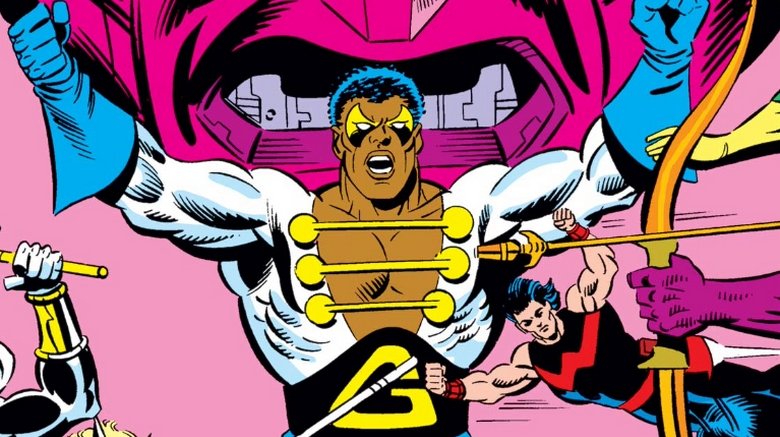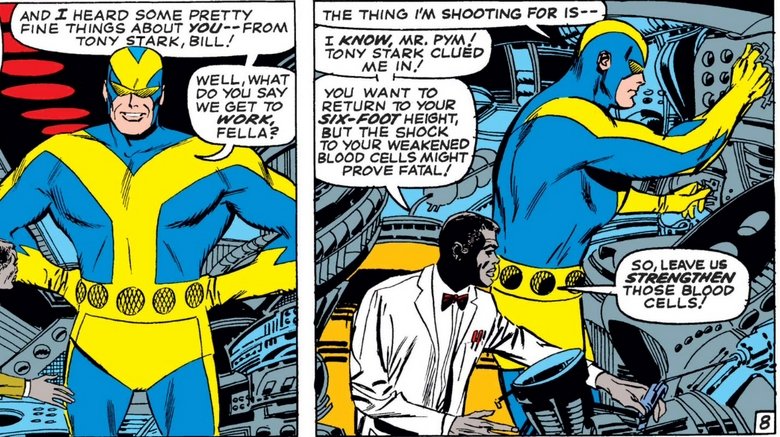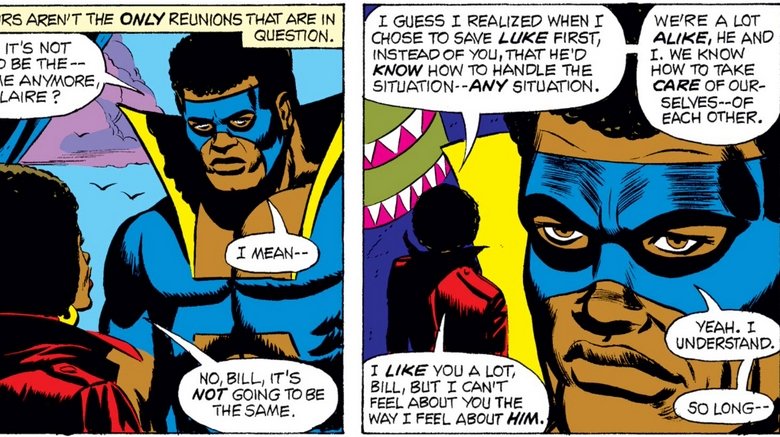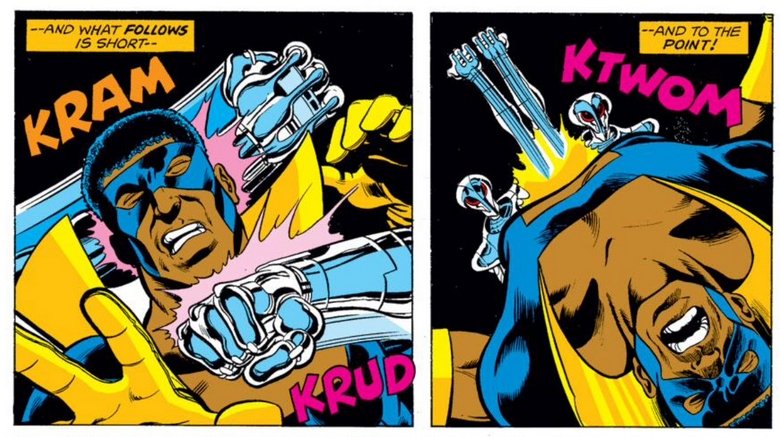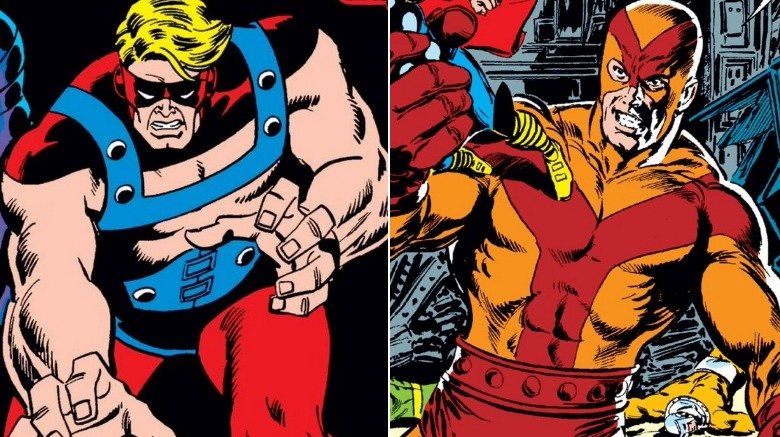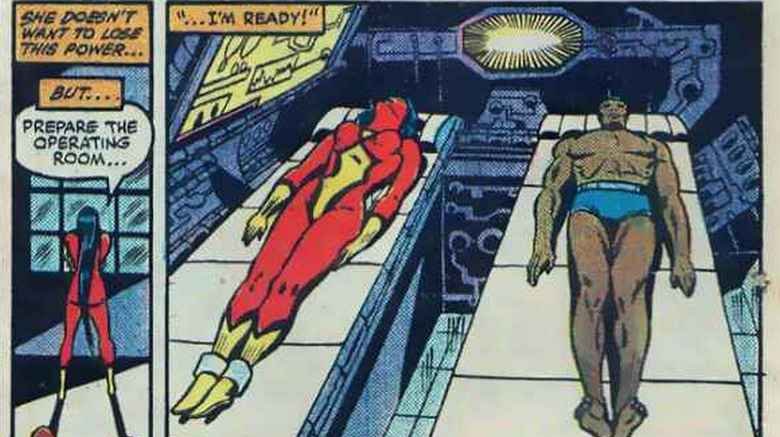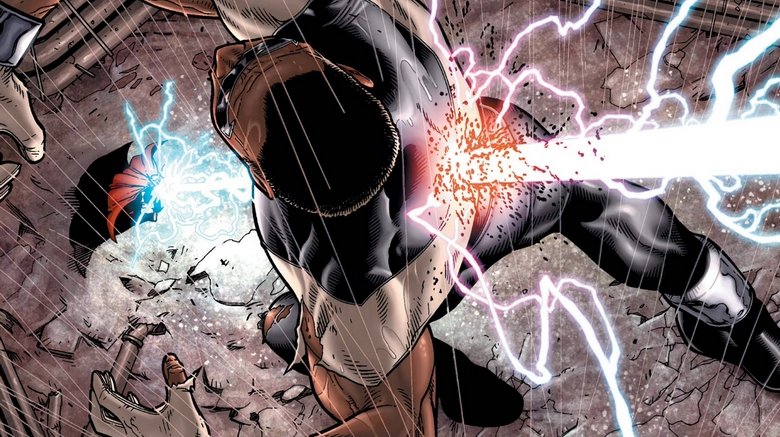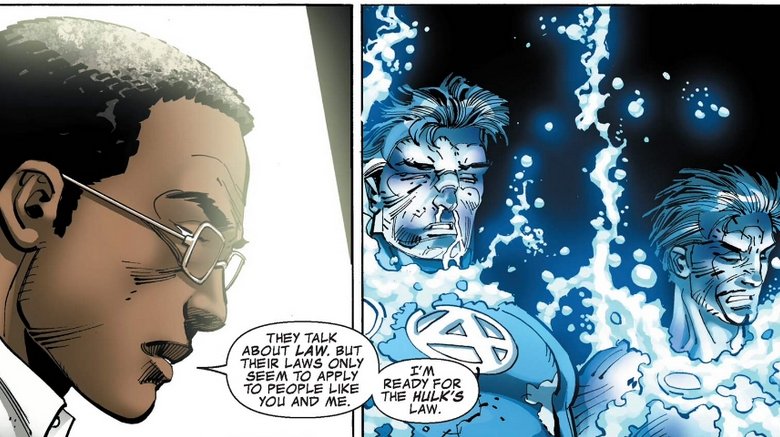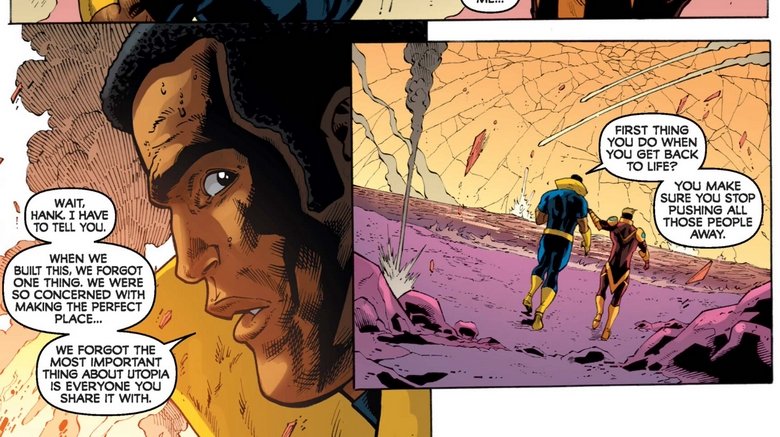The Untold Truth Of Marvel's Goliath
One of the most simultaneously tragic, unsung, and important heroes of the Marvel Universe is Bill Foster, a.k.a. Goliath.
Introduced at the end of the '60s and earning just a little bit more prominence in the subsequent decade when Marvel's attempts to cash-in on the Hollywood blaxpoitation trend won him the short-lived series Black Goliath, Bill Foster spent his fictional life on the periphery of the Marvel Universe. He worked briefly with the Avengers, the Defenders, and the Champions. He helped Luke Cage take down the Circus of Crime and teamed up with Ben Grimm in the classic Project Pegasus story in Marvel Two-in-One. He popped up in short bursts, making waves in the line-wide event Evolutionary War and finally Civil War, when he met his violent end.
In a fictional world where death tends to be as permanent as dry erase marker, Goliath remains remarkably un-resurrected after over a decade in the ground. With Bill Foster making his film debut in Ant-Man and the Wasp, it could be that the Goliath whose first shot at superhero stardom never took off might get another crack at it. Regardless, whether it acts as eulogy or prologue, here's the untold truth of Goliath.
Don't call it a comeback
Though he first showed up with super powers in 1975, Bill Foster's been a part of Marvel's narrative since the late '60s. He debuted in 1969's Avengers #32, when he was recruited to help Hank Pym. Pym was stuck in giant form and Foster, a prominent biochemist, was tapped to help him find a cure. Later in the issue, Foster was captured by the white supremacist group the Sons of the Serpent, but the Avengers rescued him. He continued to work as Pym's lab assistant, popping up again in later issues of Avengers. When Hank Pym and the Wasp were presumed dead in the pages of Marvel Feature, Foster tried to find out what happened.
Six years after his introduction to Marvel, it was revealed in the pages of Luke Cage that Foster's experiment's with Pym's science had led him to develop powers of his own. However, that story proved to be less about science gone awry, and more about a girl.
About a girl
Bill Foster's initial reason for becoming Goliath was part of a bizarre plan to get his ex-wife back.
Foster first showed up under the name Black Goliath in 1975's Luke Cage, Power Man #24. Cage's love interest, Claire Temple, was Foster's ex-wife. When Cage ran into her at a circus, she told him that Foster was stuck in his "giant" form. Foster was working as an attraction to raise the money he needed to find a cure, and Claire was there to help him.
Foster found Luke Cage and his ex-wife talking, and fists flew. After they smacked each other around for a bit, the super villain Ringmaster arrived and hypnotized both heroes. In the following issue, Cage and Foster broke free of Ringmaster's control and the good guys won; the issue ended with Claire confessing to Foster that she didn't have feelings for him anymore.
When Foster's own series premiered in 1976 with Black Goliath #1, readers discovered Foster lied in Luke Cage. Thinking about his past, Foster revealed that he was faking being stuck in giant form in the earlier appearance. "The whole Goliath schtick," Foster's dialogue reads, "was just a series of dirty little lies I used to try to trick Claire into coming back to me." He could've shrunk himself back to normal size whenever he wanted, he added — "And I'd never be so short on cash that I'd be forced to join a circus."
Don't give up your day job
Goliath gets beat up a lot. In spite of his size and the strength that comes with it, much like Giles in Buffy the Vampire Slayer, whenever the action starts, Bill Foster's just a few seconds away from getting knocked out. He even comments on this shortly after changing his name to Giant-Man in Marvel Two-in-One #55. As he fights Nuklo, Foster thinks about how badly he wants to beat the villain because how rarely he's gotten "a good, clean win." Predictably, Foster is distracted, Nuklo starts pounding on him, and Ben Grimm comes to the rescue.
Arguably, it makes sense. Foster could grow to a height of 15 feet, but he was still a biochemist, not an MMA fighter. He should have been able to take perfectly mundane challengers easily, like the muggers he wraps in light poles in Black Goliath #1. But once he started throwing down with equally "super" contenders, it follows he would face a tougher time.
Part of it is the so-called "Worf Effect," at least when it came to Goliath's guest appearances. If you want to prove your bad guy is a true threat, you have him beat the tar out of your strongest good guy (e.g. the beating Hulk took from Thanos in Avengers: Infinity War). But Foster suffered from this in his own title. He got beat up by Stilt Man — a guy who could be defeated with a taut laundry line and a strong gust of wind.
As far as superheroes go, Goliath made a great biochemist.
Always the groomsman, never the groom
In spite of his growing powers, Goliath never managed to rise above the ranks of the D-list Marvel heroes. He spent decades in the margins. He showed up in a few storylines of Marvel Two-in-One and a few issues of Champions. When Kyle Richmond's compound was swarmed with mostly D-List heroes in the classic "Defenders for a Day" three-part story, Goliath was there with unmemorable memorables like Torpedo, Stingray, and Captain Ultra. In the '80s and '90s, he showed up in stray issues of West Coast Avengers, Marvel Comics Presents, and Thunderbolts, but he never stayed around long enough for a chance at another solo career.
It's strange that, after Black Goliath's cancellation, Marvel never made a stronger push to make Bill Foster a more visible member of their narrative. Particularly when you consider the company's pushes towards greater diversity in recent years — not to mention that they've never been shy about their willingness to resurrect just about anyone who ever appeared in a single Marvel panel — it's disappointing and confusing that no genuine attempt ever materialized to make Foster's popularity match his height. As a physically powerful African-American man whose genius intellect could spar with those of Hank Pym or Tony Stark, Foster is a wonderful role model and a great example of a minority character smashing stereotypes. Maybe with the character's big-screen realization being well-received, the comics will eventually start to catch up.
What's the plural of Goliath?
Part of the reason Goliath never managed to distinguish himself among Marvel's pantheon is that he was one of many Marvel characters who used the name.
The first Goliath was Hank Pym. Goliath was Pym's third superhero name and just one of many he would adopt over the years. Clint Barton, better known as Hawkeye, was next. He proved a much more ornery and significantly less academic-minded Goliath than either Pym or Bill Foster.
The last Marvel character to take the name Goliath before Bill Foster reclaimed it was the villain Erik Josten. As part of the Masters of Evil, Josten's Goliath earned an infamous reputation after beating Hercules into a coma in 1986's Avengers #274. Josten would later change his name to Atlas when he became part of the original iteration of the Thunderbolts: former supervillains who initially disguised themselves as heroes to fool the world, but eventually decided they wanted to reform for real.
A bizarre coincidence about almost all of the Marvel characters who, at one point or another, took the name Goliath is they're all characters who enjoy changing superhero names every few years. Bill Foster was Black Goliath, Giant-Man, and finally Goliath. Clint Barton was Hawkeye, Goliath, and Ronin. Erik Josten was originally named Power Man. He changed his name to the Smuggler when Luke Cage took his first name, then there was Goliath and eventually Atlas. Finally we have Hank Pym, who changes his name more often than Snoop Dogg.
The Case of the Disappearing Cancer
During an interview about his work on Moon Knight, Warren Ellis talked about the advantage of writing a character who wasn't as popular as Marvel's marquee heroes, saying, "you can have a play with something knowing that there's not an audience of hundreds of thousands waiting with their knives out." Similarly, one of the side effects of being a D-list superhero is that large chunks of history are ignored or forgotten. Goliath is no exception.
Bill Foster revealed he was dying of radiation poisoning after a battle with the radioactive villain Atom-Smasher. In 1982's Marvel Two-in-One #85, Spider-Woman agreed to a blood transfusion that saved Foster's life, but it stripped him of his powers. He wasn't seen again until 1988's West Coast Avengers Annual #3, when Foster regained his powers while working for the High Evolutionary. He revealed he'd been battling cancer since Spider-Woman saved him, but that the illness somehow didn't affect him while he was in giant form, and told the Avengers he would stay in giant form until he could find some kind of treatment. When he showed up again in 1992 for a six-issue story in the anthology Marvel Comics Presents, there was no mention of his cancer and it was never referenced in subsequent stories.
Foster lost his powers two years later in the pages of Avengers. When he showed up briefly in 2000's Black Panther #17 in his old Black Goliath outfit, his powers were back and no one bothered to explain how.
The Fallen
Bill Foster's last words were "Get ready for the shortest comeback in history, Thor." He just didn't know it wasn't Thor's comeback he was talking about (or, for that matter, that he wasn't talking to Thor).
Goliath was barely back in the world of superheroes before he was blasted out of it. He'd been sprinkled in a couple of issues here and there during Dan Slott's short-lived Thing title as well as Friendly Neighborhood Spider-Man — just enough to make you suspect he was brought back to the edges of the Marvel spotlight to make his death more relevant.
Goliath was killed by a clone of Thor in Civil War #4. Tony Stark and Reed Richards built the clone — which would eventually be given the name Ragnarok — to help weigh the odds in their favor in their war against Captain America's anti-registration allies. When Goliath charged the clone, it held nothing back and blasted a hole through his chest.
Bill Foster's tragic end helped shape the Marvel world that existed after Civil War. His death shocked both sides and was one of the major factors that made some pro-registration heroes — most notably Spider-Man and Invisible Woman — switch to Captain America's camp.
Ironically, while Foster's superhero career started with a lie about him being stuck in giant form, it ended with the lie made true: he was buried Goliath-size, because no one could figure out how to shrink him.
In his name
When the smoke from Civil War cleared, there was one person who couldn't move on from the loss of Bill Foster: his nephew Tom.
Tom Foster first caught the attention of Marvel's heroes during World War Hulk, after a secret cabal of heroes known as the Illuminati banished the Hulk into space. The Hulk came back for vengeance and — because Tony Stark and Reed Richards were two of the Illuminati members Hulk was hunting — Tom Foster was one of the most vocal members of a group of civilians who supported the jade giant in his assault on Earth. Once Hulk and his allies captured all of the Illuminati members, Tom Foster was invited to speak at a podium at Madison Square Garden, where he told the crowd he blamed Stark and Richards for his uncle's death and that he was "ready for the Hulk's law."
After Hulk was defeated, Foster got his hand on Pym Particles and became the new Goliath, briefly joining the ranks of Damage Control. The next time he showed up, he was recruited by Wonder Man into the "Revengers," who all wanted to take down the Avengers. That ended, predictably, with Foster in prison. The next time we see him is during Civil War II, when he's paroled for helping stop a prison break orchestrated by the Mad Thinker.
A virtual Goliath
Before the 2018 Ant-Man and The Wasp film or the comic book miniseries released the same year, there was a 2010 Ant-Man and The Wasp miniseries with a completely different pair of heroes. The Ant-Man of the title was Eric O'Grady, a reformed crook and unapologetic womanizer who had joined the Avengers. The story's Wasp was the original Ant-Man, Hank Pym, who took up his wife's name to honor her after her supposed death during Secret Invasion.
In the miniseries, we learn that before Bill Foster's death at the hands of the clone Thor, Foster and Pym worked together on a virtual Heaven, and Pym had uploaded Goliath's consciousness into the digital world after his death. The virtual Heaven was under assault by the forces of A.I.M., and Pym sent O'Grady in to save Foster's soul before A.I.M. could destroy it.
Ant-Man could only get Foster's attention by disguising himself as Pym, and eventually Foster agreed to go with him. Before he would go, however, he warned the man he thought was his old friend to stop pushing away the people he cared about.
